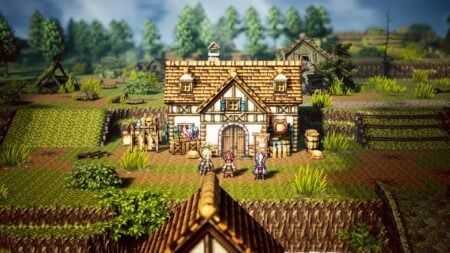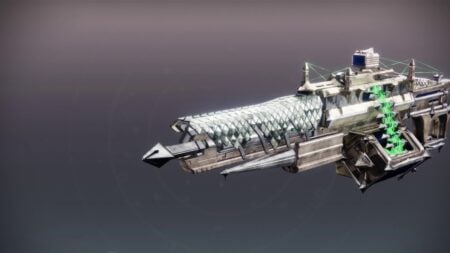Skip To...
Avatar: Frontiers of Pandora isn’t Far Cry with blue people, but it’s not far off. Ubisoft‘s newest open-world FPS captures the essence of James Cameron’s films to create one of the most breathtaking worlds I’ve seen in a game. The Na’vi are besieged by colonial humans, and it’s up to you to help them fight back. The resistance narrative is nothing new, but it goes further in grappling with its difficult subject matter than most games in the genre. There’s a lot to like here, especially during the game’s opening hours. With time, however, more and more problems reveal themselves, ultimately souring what would otherwise be a top-tier experience.
Avatar: Frontiers of Pandora Review

As a young Na’vi gaining your freedom after years under the RDA’s thumb, it’s your turn to take the fight to the humans in this open-world FPS from the team behind The Division. You’ll explore, gather resources, hunt, craft, and befriend various Na’vi tribes as you learn more about who you are and how you fit in. At last, you’ll be ready to cleanse the land of RDA compounds. Gradually you’ll drive humanity’s pollution-spewing influence from the world. Stealth, horseback riding, and flight sequences break up the action, but at the heart of everything are classic FPS shootouts, plus or minus a bow and arrow. It’s a dazzling world on the surface, but the more depth you look for, the shallower you’ll find it.
Story: A Child of Pandora

You play as one of several young Na’vi raised by the RDA as part of The Ambassador Program (TAP) on Pandora. You’ve never met your own people or explored their world. TAP’s stated goal is to improve relations between humans and the Na’vi. As the tribes push back, however, TAP’s mission changes. Some, like your friend Teylan, have been brainwashed into thinking the RDA’s attempt to colonize and exploit Pandora is justified. Others, like Nor, see through the ruse created by RDA leader John Mercer. The story explores your journey from TAP member to Na’vi Resistance fighter on the Western Frontier, a land unexplored in the films.
Stepping out into the lush greenery of Pandora for the first time is overwhelming in the best way. When you get your first glimpse of the map you begin to appreciate the staggering scope of the world. Far Cry and Assassin’s Creed: Valhalla are good comparisons if you want a sense of the game’s exploration. You can play in either Guided or Exploration Mode. In Guided Mode, every Point of Interest and mission objective is marked on your map, taking the guesswork out of exploring. Exploration Mode minimizes those intrusive elements, allowing you to explore and learn about the world yourself. It’s an excellent addition.

Avatar: Frontiers of Pandora does a great job of building upon the story of the films. Though humans exist, the Na’vi are the rightful stars of the show. With each new biome you explore, you’ll encounter new Na’vi tribes. The Aranahe, Zeswa, and Kame’tire display realistic differences in everything from their cultural practices to their weapons and hunting methods. Learning about them is a major incentive to progress. Whether you are a diehard Avatar fan eager to learn more about the native Pandorans or you’ve never seen the films, Frontiers of Pandora is a fantastic introduction to Cameron‘s world.
Side missions vary in quality, but the main story is solid. When the Big Bad wants to kidnap and brainwash children, steal resources, pollute, kill animals for sport, colonize, and otherwise ruin every good thing about a planet as beautiful as Pandora, joining the Resistance is an easy “yes.” There are plenty of games that would have been happy to paint the RDA as a cartoon villain without exploring deeper themes of colonization and ecological preservation. Frontiers of Avatar does a great job of keeping such themes at the forefront of its plot. It just struggles to follow through with some of the toughest questions.
Gameplay: On an Ikran’s Wing

The central gameplay loop of Avatar: Frontiers of Pandora resembles that of Far Cry. When you’re not pursuing the main mission, you’re exploring the giant map, helping NPCs, harvesting plants, hunting animals, crafting, attacking RDA patrols, and sabotaging RDA compounds. Hunting, harvesting, and hacking all have unique mechanics or minigames. They’re shallow, but they add a bit of spice. Crafting is more problematic. It makes perfect sense in terms of the lore. It simply doesn’t hold enough weight as a mechanic, feeling tacked on as a result. On the plus side, the game is co-op, so at least you can tackle it all with a friend.
Destroying RDA compounds is easily one of the most satisfying parts of the game. The bases pollute the surrounding area, suppressing the local wildlife and preventing you from harvesting valuable resources. To destroy them you might have to sabotage gas lines, disable electrical equipment, or otherwise cripple the facility’s infrastructure, resulting in a satisfying explosion. You can take a stealthy approach or fight your way through, but the result is the same, and your opportunities for real creativity are limited. Once you’ve cleared a compound, the cloud of pollution lifts, restoring the world to all its vibrant glory.
You have a variety of weapons at your disposal, from Na’vi bows and spear launchers to RDA guns and grenades. Weapons come in various types and qualities, and you can further customize your weapons and armor with additional parts. There are plenty of weapons in each category but few categories to choose from. Once you’ve played for a little while you’ve seen all the game has to offer in terms of new mechanics. Weapon upgrades are also disappointing, focusing on small stat buffs rather than more impactful changes. It’s a system that gives you a ton to grind for if you really want that extra 5% Weakspot Damage, but it’s not compelling. Too much of the game feels cookie cutter.

Skills help liven things up, but they suffer from many of the same problems. There are a handful of exciting, impactful Skills such as the ability to self-revive once upon death, pacify hostile animals, or run without making a sound. Yet the Skill trees are bloated with uninspired incremental buffs. Saving up points just to buy a minor buff because it’s gatekeeping something you want feels terrible. Minor buffs of this kind are far easier to balance than mechanic-altering ones, but the result is dead weight and a lack of incentive.
Considering the size of the world, there’s a small pool of distinct enemy types, leading to early repetition. Weakspot damage is essential against the bipedal mechs, larger animals, and some other enemies, due to spongy health pools. The game isn’t particularly hard, but you end up with a ton of fights that simply aren’t fun. Mediocre enemy AI and spotty stealth detection contribute to the problem. Your tiny human opponents and their equally small hitboxes don’t help, though punching soldiers across the room is great. The combat is okay, but it needs to be better in a game that relies on it this much.
At first, you’ll travel on foot, running, jumping, and climbing up vines to navigate the jungle. It’s no Dying Light, but the jungle’s impressive verticality and density make navigating it fun. Later in the game, you’ll gain access to an Ikran, one of the pterodactyl-like creatures from the movies. Ikran flight is one of the game’s best features. The controls are intuitive and flight feels good, but the best part is just watching the gorgeous landscape fall away beneath you. It’s not the only mount you’ll receive, either, and the game does a great job of incorporating these new methods of travel into gameplay.
Graphics & Audio: Theme Park Attractions

The Threaded River carves through the jungle undergrowth like a translucent knife. Moss and vines hang from the trees, throwing a green veil over the landscape. Above the sound of rushing water, you can hear animals panicking, flushing through the tangle of trees ahead. As you crest the ridge to investigate, you hear RDA soldiers chattering amongst themselves. It’s a hunters’ camp. Butchered animals lie in a pile to one side, their meat and hide ruined by bullets. Drawing your bow, you move into position.
Far Cry 3 and Green Hell are some of the only games to have done jungle settings this well. Avatar: Frontiers of Pandora is visually stunning. There are occasional mistakes, such as missing textures or floating grass, but it doesn’t get much better overall. Whether you’re riding your Ikran, climbing vines in the jungle, or walking the wide-open savannah, it’s the kind of game where you can open Photo Mode, spin your camera in any direction, and take an incredible screenshot. If Frontiers of Pandora has a solitary triumph, it’s the visual design.

The sound design is decent, but it doesn’t pack nearly the same punch. The ambient noise is flatter than it should be, and your movements sometimes fail to capture changes in texture and terrain. Most animals, weapons, and other features get a B+. There are some low-end outliers, but nothing that ruins the experience. The same can’t be said for the voice-acting. The NPC performances are high-quality in general, which is what makes your own character’s vocal performance so painful. There’s a deadness that seeps through many lines of dialog, killing whatever emotion the dialog could’ve provoked.
The biggest disappointment with the graphics and audio is there’s simply not much beneath them. When the novelty wears off, you’re left with a gorgeous, multi-layered, fundamentally barren landscape. No amount of striking foliage can distract from the lack of actual content. After playing on Exploration Mode for a while, I ultimately switched to Guided Mode and let the game usher me from one glowing quest objective to the next. Avatar: Frontiers of Pandora is a theme park game, most satisfying when you turn your brain off and let it escort you from one attraction to the next. There aren’t enough secrets and interesting POIs to encourage you to do otherwise.
Conclusion: A Case of the Blues

I experienced no crashes and few bugs during my time with the game. If you want a wide but shallow Far Cry clone with better movement and worse gunplay, this is it. It tries to fuse FPS with RPG, crafting game with walking sim. Ultimately it stretches itself too thin to see its mighty ambitions through. Seeing a lackluster character creator side-by-side with expensive cosmetics and a Season Pass in the ever-present Ubisoft store should tell you the game’s priorities. It’s an indisputably beautiful world, it just doesn’t have as much heart as the Na’vi it contains.
Avatar: Frontiers of Pandora is available for PC, PlayStation 5, and
Avatar: Frontiers of Pandora (PC Reviewed)
A sci-fi-skinned Far Cry clone that falls short of both the game and film that inspired it.
Pros
- Breathtaking setting
- Solid movement
- Good storytelling
Cons
- Mediocre combat
- Unfulfilling exploration
- Mechanics often clash rather than harmonize







